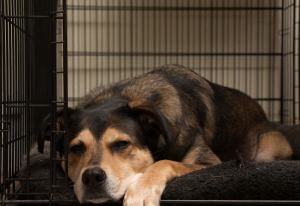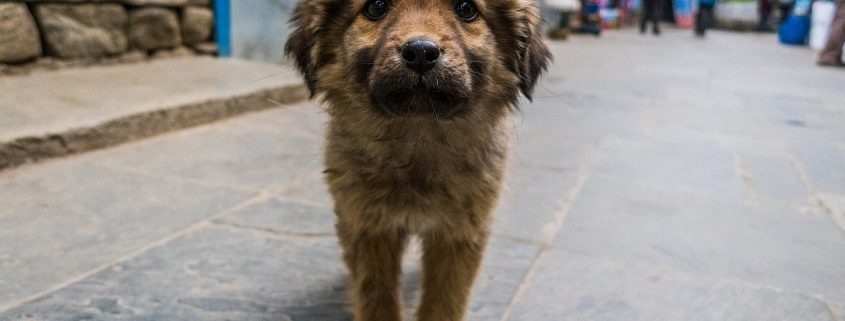Ask Crystal: Rescue Dog Decompression
Welcome to “Ask Crystal,” where you can ask your pet behavior questions! You can submit your question for Crystal at the bottom of the page!

Dear Crystal,
We got a second Romanian rescue dog 10 days ago. He is not afraid of people as our other dog Grace was. Noodle is like a tiny Fox Haired Terrier. Grace is a gem on the lead and a very calming influence on Noodles.
He is already walking well on the lead but is frantic to play with other dogs we meet. Standing up like a Meercat, pawing the air and almost screaming. If the other dog retaliates, he gets more aggressive.
He understands NO. I have managed to get him by, walking him past on a very short lead up on his hind legs. He seems to calm down very quickly. We tend to take him where we won’t meet many dogs. My daughter who owns him finds taking him on the beach where you see more dogs is disastrous.
We all live in the same house. Noodles stays mostly downstairs, and Grace stays mostly upstairs with us.
Noodles follows my daughter everywhere. Tracy is trying to leave him alone with us for a short while most days to break his separation anxiety. Is it too soon?
Please, have you any tips for us?
Sincerely,
Romanian Rescue Mom
Dear Romanian,
I have been getting a lot of questions lately on Romanian rescue dogs. It certainly seems the practice of rescuing these dogs is gaining in popularity. The hard part for a lot of dog owners regardless of their dog owning experience is that these dogs don’t live like the dogs we are used to. Obviously, we may not know the history of Noodles or Grace but we can postulate based on how these dogs typically live and then see if we can gauge the potential causes of the behavior.
His previous life was likely him roaming around as he chose, finding food and playing. Now all of a sudden, we tell him where he can be, when he eats, where he sleeps and who he interacts with. Choice is a basic need of all animals and his choices have just been suddenly taken away from him.
Add to his choices being taken away all the sounds of a normal household. Doors open and closing, TV noises, radios, computers, phones, appliances, people talking, buzzing lights and people coming in and out. Not to mention all the strange smells of cleaning products. There is a lot for him to get used to and it is probably very overwhelming and confusing.
All this to say, I would suggest a few weeks of keeping him mostly inside the house and short trips to the backyard. Normal dogs need at least 72 hours to decompress from all the stress of being in a shelter and being adopted. Some dogs take weeks or months to decompress and settle in if they are fearful. Consider working on getting him used to his home first. Keep his world small right now. I know it is exciting to get a new dog but you don’t need to do everything right away.
If you are feeling concerned with how much exercise he is getting on a daily basis, then it might ease your mind to know that Sindhoor Pangal’s studies of “The Lives of Streeties” in India reveals that these dogs spend most of their time napping, watching the world go by, hanging with their dog friends and finding food. He is likely not accustomed to a great deal of exercise.
 Given what we know about how they tend to spend their day, it is important to include a good balance of food enrichment, exercise, playtime with other dogs and quiet time. I would suggest feeding him by scatter feeding. It may be closer to what he is used to than a bowl and you can use it as a distraction technique when you notice other dogs out on walks before he starts reacting. It’s really simple to train. Start inside the house and say “scatter” and toss some kibble on the ground. As long as it doesn’t startle him, feed him his dinner this way. If your floor is hard and it makes a lot of noise, you could throw it on a rug or use quiet treats at first to train. Then move your training outside in the backyard and then on walks as he gets better and better. Eventually when you see a dog, hopefully before he does, step off the sidewalk or as far away as you can and say “scatter” and toss treats in the grass. If you have trained him enough inside the house and if he really likes it, it can distract him or allow him to notice distractions but not react to them.
Given what we know about how they tend to spend their day, it is important to include a good balance of food enrichment, exercise, playtime with other dogs and quiet time. I would suggest feeding him by scatter feeding. It may be closer to what he is used to than a bowl and you can use it as a distraction technique when you notice other dogs out on walks before he starts reacting. It’s really simple to train. Start inside the house and say “scatter” and toss some kibble on the ground. As long as it doesn’t startle him, feed him his dinner this way. If your floor is hard and it makes a lot of noise, you could throw it on a rug or use quiet treats at first to train. Then move your training outside in the backyard and then on walks as he gets better and better. Eventually when you see a dog, hopefully before he does, step off the sidewalk or as far away as you can and say “scatter” and toss treats in the grass. If you have trained him enough inside the house and if he really likes it, it can distract him or allow him to notice distractions but not react to them.
You may try some easy make at home food enrichment like food in open cardboard boxes or tubes. He is probably used to foraging so you can probably make it harder pretty quickly. I like to make sure to hand the box to the dog so that they understand that they only can have things that are given to them. I would guess some of the enrichment toys like Kong Wobblers are too noisy at the moment but could be ok once he settles in.
Take some time throughout the day to work on his training. That will also provide mental stimulation and help tire him out. More importantly, it will give you a way to communicate with him and work on his reactivity skills.
Attention is a critical first step in training the reactive dog. If you can keep the dog focused on you, then you can either move past the other dog or use distraction techniques. For this to work, you need to have the dog’s attention before it sees the other dog. Attention games will also help him to learn to feel comfortable making eye contact which is not natural in most street dogs.
Watch Me can be a useful verbal cue for eye contact which may be a good starting place if he is unlikely to make eye contact unsolicited. Once he starts getting comfortable with eye contact, you can teach your dog an auto check-in so that they learn to check in with you every several seconds. To train this, stand inside with the dog on a leash and mark and treat any times the dog turns to look at you. If your dog doesn’t offer check-ins or eye contact, work on eye contact games such as Up/Down and Ping Pong to make it more fun and engaging for him.
It is important to have trained behaviors which help with management when unexpected encounters occur. I already mentioned the scatter technique but you may also want to teach Find It. Find It teaches the dog to search the ground for treats. If his nose is engaged and pointed down, he is less likely to notice the trigger. Many dogs really enjoy this game, so it may help to create a positive association with other dogs. The Emergency U-Turn is an escape cue to get the dog moving in the opposite direction in a fun, upbeat way.
There are some cues that you can work on which will help teach your dog to build up their frustration tolerance. Wait at doorways and for food bowls is an easy behavior to teach and teaches the dog to wait for a moment before getting something they want. Leave It is a very useful cue that teaches a dog to leave something and come back to you.
 If Noodles was a street dog, then he is very likely not used to being on a lead. And that goes beyond the feeling of being on the lead. He is very likely used to be able to either walk up to or not, other dogs. Leads cause a lot of problems for many dogs because of the restriction of natural movement. They do not allow the dog to make choices and to move in a natural manner. Add to that many owners trying to make dogs make friends by walking the dog straight up to a stranger dog and you have a lot of issues with dogs being reactive on leash.
If Noodles was a street dog, then he is very likely not used to being on a lead. And that goes beyond the feeling of being on the lead. He is very likely used to be able to either walk up to or not, other dogs. Leads cause a lot of problems for many dogs because of the restriction of natural movement. They do not allow the dog to make choices and to move in a natural manner. Add to that many owners trying to make dogs make friends by walking the dog straight up to a stranger dog and you have a lot of issues with dogs being reactive on leash.
It sounds like you feel like he is trying to play with the other dogs. Frustration is a common reason why dogs are reactive so that could very well be the case. It can however, be hard to tell the difference between a dog that is reactive due to frustration or fear. I would guess that because you have already introduced him to Grace and presumably, they get along well that it may be the case.
Walks are not essential in the first few weeks and they may be more harmful than helpful at this initial stage. Your dog in addition to not being used to being on a collar and leash, may be overwhelmed by taking walks right now. We do not want to add any additional stress. Ideally, we start leash walk training inside the house anyway so you can start by walking him around your house on his leash and feeding a treat for each step and as he gets better slowly add steps in. Once the dog gets the hang of walking inside, practice walking in the backyard and then the streets in front of the house and slowly get further and further away.
Reactivity is an emotional issue. While we work to manage the dog’s behavior to keep him sub-threshold, we should also strive to change his emotions surrounding his trigger. Counter-conditioning is used to change a dog’s emotional reaction to a trigger. We change his emotional response by creating a new association of the trigger with something the dog enjoys. This is usually done with high value treats, but it could be play with a favorite toy or even an activity that the dog enjoys.
If your dog is frustrated reactive, you can use the fact that he really wants to go say hello to the other dogs as a training motivator. Start at his threshold distance. This is where he can notice the other dog but not become frantic or excited. As long as your dog remains calm, slowly move forward. The moment that he begins to get excited, turn and walk around to whatever distance he needs to calm down. As you repeat this procedure many times, the dog should begin to realize that his calm behavior allows him to move closer. Once he is able to make it all the way up to the other dog, take a calm parallel walk with the other dog. We don’t want to let the dog immediately start playing with the other dog because that will reinforce the idea that he gets to play with every dog he walks up to. Save off-leash play time for a little bit later in the walk. If the dog is getting more and more frustrated, you may want to use a different technique for this dog.
 As far as him following her around all day, I would suggest that he has a safe space with a crate and a dog bed. Have your daughter leave him in the space for a minute or so and come back in the room. Do this several times if possible, through the day. Slowly she can start adding more and more time to how long she is gone from the room. She can then start to vary the time she is gone so sometimes its longer and sometimes short I think most people leave the dog alone for too long too soon. It’s important to build slowly. He is probably really not comfortable, and she is the most familiar thing to him. We don’t want to make it worse by having her leave for longer than he can tolerate if possible.
As far as him following her around all day, I would suggest that he has a safe space with a crate and a dog bed. Have your daughter leave him in the space for a minute or so and come back in the room. Do this several times if possible, through the day. Slowly she can start adding more and more time to how long she is gone from the room. She can then start to vary the time she is gone so sometimes its longer and sometimes short I think most people leave the dog alone for too long too soon. It’s important to build slowly. He is probably really not comfortable, and she is the most familiar thing to him. We don’t want to make it worse by having her leave for longer than he can tolerate if possible.
I am sure it sounds really overwhelming but remember to take it easy on yourself as well. I really like training games that are fun for humans and dogs. Train in short bursts throughout the day and work on multiple things in a lesson and he will have some skills before you know it. And if you aren’t taking a lot of walks, you will have more time to train. I hope these tips are helpful and good luck with your new addition!
Until next time,
Crystal







